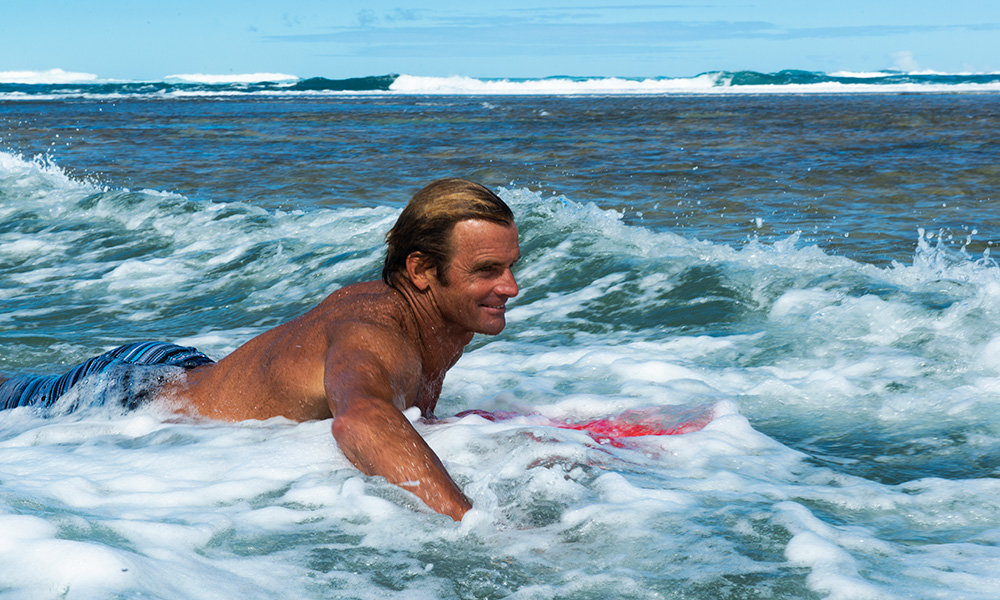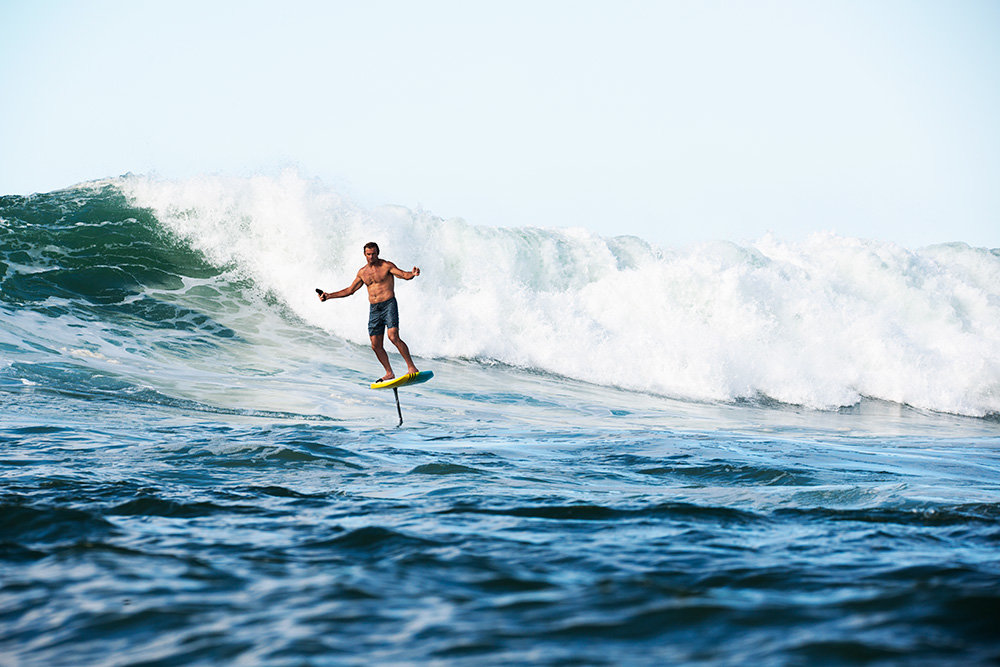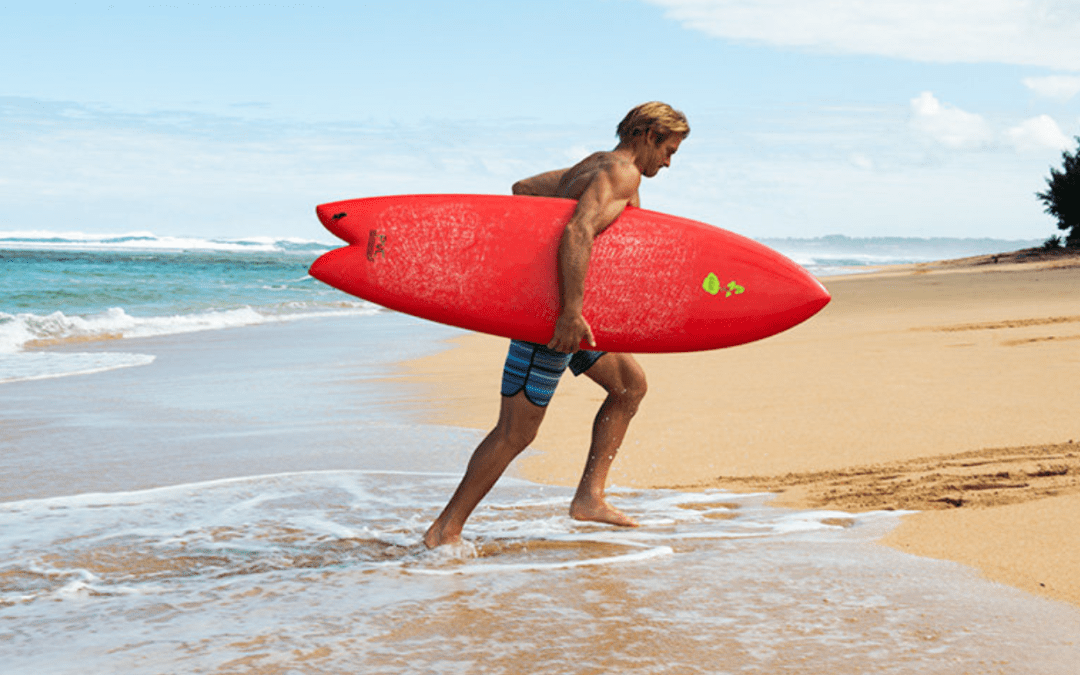Laird Hamilton: The Fear Factor
For legendary surfer Laird Hamilton, facing death is the best way to appreciate life

My head bursts through the icy water and I gasp involuntarily for air. My heart is beating wildly, my body in full panic mode. Crouched at the foot of a 110-gallon stainless steel tub, holding an iPhone stopwatch, Laird Hamilton stares intensely into my eyes and instructs, evenly: “Breathe, dude … breeeeathe.”
I try to comply, focusing on slowing my breaths while resisting the impulse to leap out of this frigid bath and run away. But there is something in that husky voice, something in the stare, that makes the idea of immersing myself in 34-degree water sensible. I am out of my depth here, but I also want to understand the relentless force that is Laird Hamilton—a man who, at 55, is still breaking boundaries in the ocean. So, I continue to breathe, nostrils flaring. Dubbed “World’s Greatest Athlete” by The Washington Post in 2011, Hamilton has never been big on moderation. Co-inventing “tow-in surfing” decades ago in order to surf mountains of water once thought too large to ride, he has made a career out of pushing the boundaries of reasonable behavior. He also has various sidelines—as a fitness guru, an occasional movie stuntman and a relentless entrepreneur, with self-branded lines of apparel, paddle boards and whole foods. In his spare time, he writes books.

This month, Hamilton is publishing his latest title, Liferider: Heart, Body, Soul, and Life Beyond the Ocean, which explores ways to apply his own extreme experiences to everyday activities. A key part of this endeavor is tapping into the power of fear, which is why I have found myself mimicking the experience of freezing to death in a tub on his property in Kauai, the fourth-largest island in the Hawaiian Archipelago.
“I tell people that they should get scared. It’s good for our systems,” he says. “Our systems were designed to be under threat. Want to see an antelope run fast? Have it get chased by a cheetah.
Fear makes you see better, it makes you hear better, it makes you think better— once you’re used to harnessing it.”
Also known as the Garden Isle, Kauai typically reveals its verdant beauty in glimmers between showers. This morning it is clear and windless—a stock image of paradise. I arrive at Hamilton’s compound, which is hidden from the road by heliconia blossoms, and am greeted warmly by his wife, Gabrielle Reece, who is also no slouch when it comes to testing limits (her CV includes stints as a pro volleyball player, TV presenter, fashion model, author and actress). Tall, slender and radiant, she begins with a caveat, more or less warning that her husband does not suffer fools gladly. A moment later, Hamilton surges through the door, shirtless and barefoot, with an expression that is friendly but also searching.
“We good to go?” he says, and I follow him downstairs, fumbling with my shoes on the way out. I will not make Hamilton wait. We slide into a souped-up, camo-colored golf cart and Kawa, his feisty decker rat terrier side – kick, hops over me and sits between us, staring dutifully ahead as we ramble down a dirt road toward I’m not sure where. “You’re not the type to sit still, huh?” I say, and Hamilton grins: “A rolling stone gathers no moss.”
We skid to a stop at the bottom of the hill and walk into a large barn. I look around, bewildered. We have entered Hamilton’s workshop, or toyshop. Above us, an array of two dozen “guns” (lengthy big-wave surfboards) hangs from the rafters. Dozens of stand-up paddle boards lean against a wall. There are kayaks and wakeboards, tow-in boards and kitesurf boards, paddles of all sizes. On another wall hangs a row of foil boards, whose design allows surfers, once they’re up to speed, to perch two or three feet above the water’s surface, thanks to an elongated hydrofoil stemming from the bottom of the board.
“Imagine that you’ve surfed 50 years and suddenly you’re feeling sensations that you’ve never felt in your entire career,” says Hamilton, who was instrumental in developing the first foil board prototype 25 years ago. “It reignites your flame. It reenergizes something in you about the ocean. You’re pretty much flying.”

Hamilton admits that, after decades on the water, he often requires this sort of reinvigoration. “I plateau and get bored,” he says, handing me a cup of coffee (his own brand). “When you feel you’ve peaked at something, it’s less interesting and probably time to move on. To be the best person you can be, you have to keep progressing.”
Born in San Francisco, Hamilton and his mother moved to Hawaii when he was an infant, not long after his parents separated. Living by the beach at Pipeline on Oahu’s North Shore, he gravitated toward the ocean as a toddler, getting rescued by lifeguards “around once a week,” he recalls.
His mother eventually met and married Bill Hamilton, a famous surfboard shaper, and the family moved to Kauai. While Laird excelled in the water, on land he floundered— he recalls being a terror in the classroom and troublesome at home. “People have always called me a contrarian,” he says with a laugh, “and that’s probably a fair judgement.”
Dropping out of high school in the 11th grade, he moved back to Oahu to surf, working his way up the vicious pecking order at the Banzai Pipeline. He landed modeling gigs to pay the bills—his first big job was a shoot with Brooke Shields for Life—and in his early 20s was cast as the antihero Lance Burkhart in the surfer classic North Shore.
In the early ’90s, in an attempt to solve the puzzle of how to surf waves too large to paddle into, Hamilton and a group of friends began to tow each other by Jet Ski into massive surf off Hawaii’s outer reefs. They became known as the “Strapped Crew,” and their method caught on around the world. In the summer of 2000, at Teahupo’o, Tahiti, Hamilton was towed into what became known as the Millennium Wave, a 20-foot-tall monster so heavy, and rolling over such shallow reef, it was regarded to be the most dangerous wave ever ridden. Already a star in the surfing world, the feat garnered Hamilton wider celebrity. He appeared on 60 Minutes and Late Show with David Letterman and on the covers of Esquire and Men’s Journal.
Over the years, Hamilton has sought ways to recreate—or even top—the thrill of the Millennium, which is why he is so excited about foil boarding. Back in the barn, he tinkers with an eFoil, which is fitted with a motorized prop. “This is what’s needed to catch the largest waves possible,” he says, grinning. “Let me show you what I mean.”
A few minutes later we’re in a boat, drifting down a jungle river toward Hanalei Bay. Last year, after a violent storm flooded the land around us, Hamilton used his boat to deliver supplies and evacuate stranded residents. At around the same time, his other home in Malibu was nearly consumed by wildfires. “I’m always telling people how I need excitement,” he says, “but not that much.”
We motor into the bay. When the water gets smooth enough, Hamilton throws his legs over the rails, places his feet on the eFoil, presses the trigger and zips away, barreling faster and faster, then hovering a few feet over the sea surface. I watch him fly around, leaning forward into his turns, his arms spread out in his signature Hamilton-stance, as if he’s bear-hugging the universe.
After a while, he glides back to the boat and tells me that the eFoil’s low on charge, so I’ll have to sit this one out, which is a bit disappointing. Hamilton’s ultimate aim is to take a board like this into the biggest waves ever ridden, an ambition that does not lend itself to a sharing-is-caring outlook. “These things take on a relentlessness,” he says, pulling the board back into the boat. “It’s an obnoxious, relentless pursuit that might even make it difficult for people to be around you.”
That afternoon, back at the family compound, Hamilton, Reece, Kawa and I hop into a pickup, rolling down the hill and over a one-lane bridge into Hanalei for lunch at a cluster of roadside food trucks. As we eat, talk turns to Liferider, and how the book’s lessons can be applied to less swashbuckling lifestyles. “Only so many people are going to be able to surf like Laird surfs,” says Reece, “but his insights are still things people can relate to on land or in anything they do.”
Hamilton argues that being conscious of one’s breath, for example, can be as beneficial in the workplace as in the ocean. A huge proponent of conscious breathing, he urges readers to listen to their breath as a way to conquer doubt and block out the distractions of the modern world. In terms of risk-taking, he equates surfing to entrepreneurship. “I think risk has a certain formula to it—a certain logic,” he writes. “If you’re not prepared to get the biggest wave of the day on your head, then you probably shouldn’t be out there. Business is no different; just the outcome’s a little less severe.”
As Hamilton speaks, a young boy from New Zealand plucks up the courage to ask this rugged-looking, six-foot-two dude if he’s a surfer. “Yeah,” he replies, smiling, “I dabble.” The boy’s mother asks Hamilton to take a look at a cut that won’t heal on the boy’s toe and he holds the injured foot in his hands. “Don’t eat candy,” he says. “Sugar is bad for healing.” With this, he jogs back to the truck and returns with a tube of antibacterial ointment. “Well, there’s a story you can bring home to your mates,” says the boy’s dad.

After lunch, I follow Hamilton back to the barn for the mock hypothermia session— though I don’t know it at the time. As I watch him fill the steel tub with a hose, he returns to my question about how to apply the lessons in his book, which in turn brings us back to the topic of mastering fear. “When you’ve been through the process of being scared enough times like I have, you do get a certain comfort level with it,” he says. “I mean, I was scared so often and so much as a child, getting swept out to sea at Pipeline, that I developed a reverence for fear early.”
I point out that most kids who touch a hot iron usually stay away from irons for a while. “I guess I just couldn’t be discouraged when it came to the ocean,” Hamilton replies. “And I also liked the feeling it gave me, after I survived something that scared me.” For him, fear is not only invigorating, but a means of self-improvement and self-awareness. “Everyone,” he says, “should experience fear at least once a day.” I ask if constructive fear ever crosses over into mortal dread, and Hamilton rattles off a few close calls—getting lost at sea while paddle boarding, being pinned beneath a waterfall while swimming, getting caught in an avalanche while snowboarding—before handing me a bucket and pointing to a pile of ice: “I’ll shovel, you fill.” And then: “You first.”
Despite vigorous protests from my nervous system, I plunge into the water because, well, Laird Hamilton told me to. A few minutes later, he leads me into a sauna to jumpstart my circulation and explains that the ordeal—or, rather, the fight-or-flight mechanism it triggered—gets to the heart of his lifelong tendency to court danger. (XPT Ice-Heat Recovery)
“People might think that I’m an adrenaline junkie, but I disagree,” he says. “I think I’m a life junkie. Fear makes us feel alive, and I like feeling alive.”
